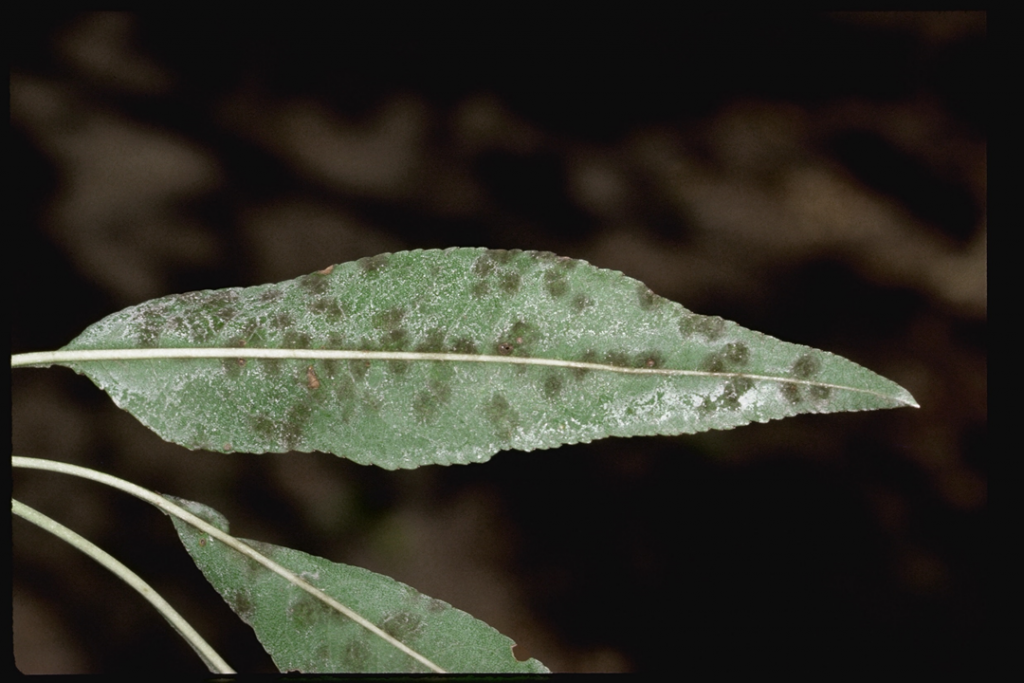Adapted from the article “Tackling Last Season’s Outbreak of Almond Scab in Spring 2007 – An Update” by Joseph Connell, UC Farm Advisor, Butte Co. in the April 2007 Sacramento Valley Almond News.
Almond scab is a fungal disease of twigs, leaves, and fruit. Symptoms develop in spring and early summer and may cause pre-mature defoliation of trees. The disease is caused by Venturia carpophila (anamorph – Cladosporium carpophilum). Almond scab is common throughout the almond production regions of the Central Valley, especially in locations with high humidity (e.g., along rivers, orchard low spots, frequently irrigated orchards, sprinkler irrigated orchards) and poor air circulation.
Symptoms
Symptoms of scab develop slowly, 4 to 6 weeks after initial infection. On leaves, symptoms begin as indistinct, green-yellow lesions on the underside and later on both sides of the leaves. Once the fungus sporulates, lesions turn olive green. Extensive leaf infections may result in tree defoliation.
On fruit, small, green to olive superficial, circular spots develop mostly on the upper exposed surface. The spots enlarge, turn dark olive to black, and often coalesce, but do not result in fruit drop. On young twigs distinct, slightly raised, circular to oval, water-soaked lesions can develop in the spring. By fall, they are dark brown and slightly elongated.

Almond Scab.
Treatment
In recent years, resistance to strobilurin fungicide (e.g., Abound, Gem, and Pristine) has been a problem in the northern Sacramento Valley. Growers that have previously used the strobilurin fungicides at more than two applications per season and who have made alternate-row applications or have applied the single-site mode of action strobilurin fungicides by air to trees with a full canopy have been the first ones to report problems.
Four trials were set up in Butte Co. in the spring 2007 season. In trees that were treated with dormant or delayed dormant liquid lime sulfur (LLS), scab twig lesions were not sporulating as of March 21. Lesions on trees that were not dormant-treated were sporulating at that time. Approximately 50 to 75% of the lesions collected from the four locations had heavy sporulation of the pathogen C. carpophilum. Nearly all isolates sampled were resistant to the strobilurin fungicides. There is no partial resistance. Resistant pathogen can grow in the presence of high concentrations of the fungicide.
Trials are ongoing to evaluate fungicide rotation programs that do not utilize the strobilurin fungicides, going back to older multi-site mode of action fungicides registered on almond. Programs are comparing applications of captan, maneb, ziram, or chlorothalonil at petal fall at the onset of twig sporulation. This treatment is followed by captan, maneb, or ziram about 5-weeks after petal fall. Subsequent applications will utilize wettable sulfur and captan in rotations or in mixtures. This is a sound program that should prevent resistance from developing to any of these fungicides.
Late January delayed dormant application of copper and oil has been the most effective treatment in reducing the production of scab spores from the overwintering twig lesions. These dormant applications delay and reduce the spore production from twig lesions. Spring sprays in March and April only focus on protecting the leaves, fruit, and young twig tissues from new infections but don’t affect the spore formation on the current twig lesions.
Growers that do not have strobilurin resistance can still use strobilurin fungicides but should limit their total application to one or two per season. If two applications are made, then they should never be made in back-to-back, against a high population (i.e., mid- to late season), or differing from labeled rates (e.g., alternate row applications, air applications, etc.). Ideally, applications of two strobilurin fungicides per season should be done early against the disease and separated by the use of multi-site mode of action fungicides before and after their application.


Leave a Reply